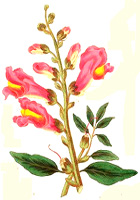
When you look at a plant or seed catalogue, everything is depicted in full bloom. And the neophyte may have the impression that that’s the way a garden should look! Au contraire, each plant has its bloom time in its “own season,” and the display in each garden is a staggered choreography. A good gardener will capitalize on his knowledge of bloom time and combine plants whose habits are similar to parts of the garden with “like” plants. A friend of mine describes the garden as having sections that are “Queen For a Day.” There are times when a section will be all green (while getting ready to get ready), and then that will morph into an area of gorgeous bloom and breathtaking color. And then … nothing! Bloom is spent. Color has disappeared. The drama is gone. By then, something in another part of the garden is in bloom, and the focus changes to that section.

One of the challenges of successful gardening is to install plants in such a way that the morphing to a new phase of bloom is done right at that same spot. For instance, plant pansies in a daffodil bed so that they have color, then the daffs take over, and then the pansies shine through while the leaves are ripening on the spent blooms of the daffodils.

Each garden will choose to play a different game with himself in the garden. Some want to keep the focus all in one spot, and some want the focus to shift. Whatever your preference is, keep records. Your plants can be positioned to act as a team in the garden and help to contribute to the total effect, when you know what works in tandem with what.
 When you look at a plant or seed catalogue, everything is depicted in full bloom. And the neophyte may have the impression that that’s the way a garden should look! Au contraire, each plant has its bloom time in its “own season,” and the display in each garden is a staggered choreography. A good gardener will capitalize on his knowledge of bloom time and combine plants whose habits are similar to parts of the garden with “like” plants. A friend of mine describes the garden as having sections that are “Queen For a Day.” There are times when a section will be all green (while getting ready to get ready), and then that will morph into an area of gorgeous bloom and breathtaking color. And then … nothing! Bloom is spent. Color has disappeared. The drama is gone. By then, something in another part of the garden is in bloom, and the focus changes to that section.
When you look at a plant or seed catalogue, everything is depicted in full bloom. And the neophyte may have the impression that that’s the way a garden should look! Au contraire, each plant has its bloom time in its “own season,” and the display in each garden is a staggered choreography. A good gardener will capitalize on his knowledge of bloom time and combine plants whose habits are similar to parts of the garden with “like” plants. A friend of mine describes the garden as having sections that are “Queen For a Day.” There are times when a section will be all green (while getting ready to get ready), and then that will morph into an area of gorgeous bloom and breathtaking color. And then … nothing! Bloom is spent. Color has disappeared. The drama is gone. By then, something in another part of the garden is in bloom, and the focus changes to that section. One of the challenges of successful gardening is to install plants in such a way that the morphing to a new phase of bloom is done right at that same spot. For instance, plant pansies in a daffodil bed so that they have color, then the daffs take over, and then the pansies shine through while the leaves are ripening on the spent blooms of the daffodils.
One of the challenges of successful gardening is to install plants in such a way that the morphing to a new phase of bloom is done right at that same spot. For instance, plant pansies in a daffodil bed so that they have color, then the daffs take over, and then the pansies shine through while the leaves are ripening on the spent blooms of the daffodils. Each garden will choose to play a different game with himself in the garden. Some want to keep the focus all in one spot, and some want the focus to shift. Whatever your preference is, keep records. Your plants can be positioned to act as a team in the garden and help to contribute to the total effect, when you know what works in tandem with what.
Each garden will choose to play a different game with himself in the garden. Some want to keep the focus all in one spot, and some want the focus to shift. Whatever your preference is, keep records. Your plants can be positioned to act as a team in the garden and help to contribute to the total effect, when you know what works in tandem with what.

No comments:
Post a Comment